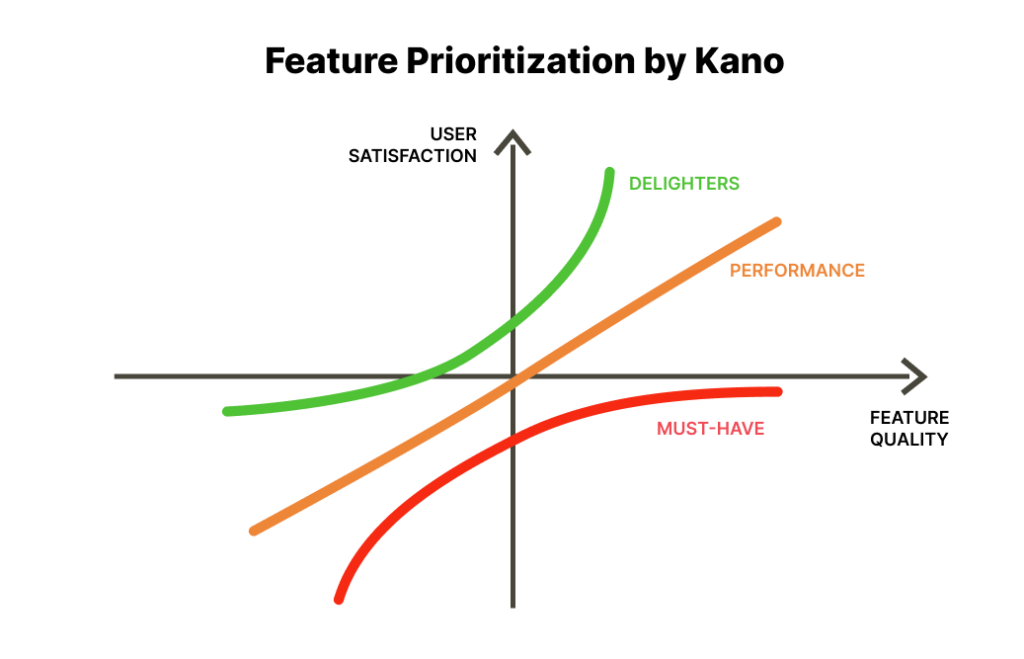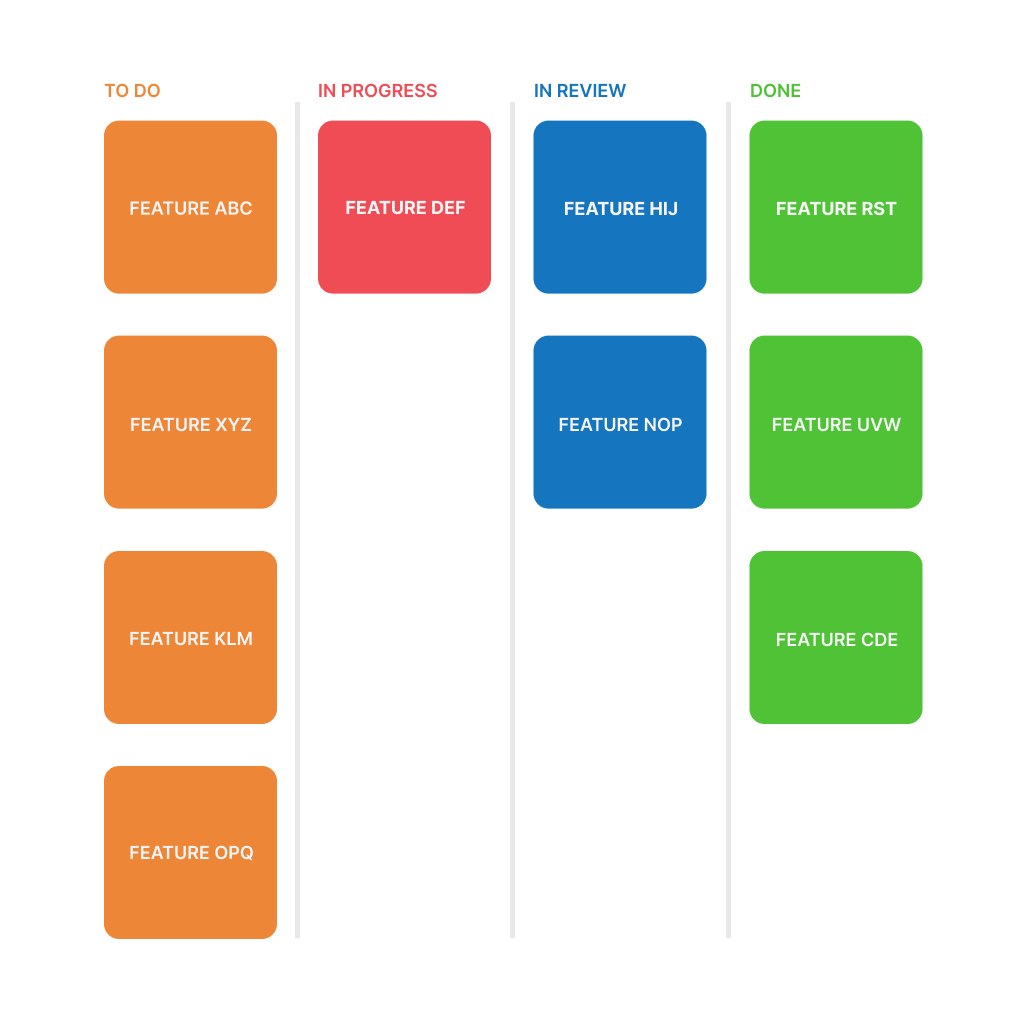You’ve got this killer business idea. It’s gonna be HUGE. You can feel it.
You have all these plans and I know you can’t wait to make your product a reality. You probably already thought of extraordinary ideas, amazing features, and benefits that will change lives…
But if you want your product to be a success, slow down. Take a breath.
As much as you’d like to simply stuff every possible feature into your product – you need to be strategic about it. First, you need to know which features you need to prioritize and which features can wait.
Some features are more impactful than others – and I’ll teach you what to prioritize.
(Note: Which product features to prioritize. Not the self-help coach kind of prioritization.)

The Kano Model is a method that professional product managers use to guess how much a certain feature will satisfy their customers depending on how well it is implemented. You do that by dividing your product’s features into three main categories:
Woah, that’s a lot of car rides you just took, princess. Hope you had some time to think about your product!
Sometimes it’s hard to understand if a feature is Must-Have, Performance, or Delighter by Kano.
A good lifehack here is:
Think about why you want to build a specific feature.
If the answer is: “I’m running away from something and trying to avoid losses or risks” – then it’s probably a Must-Have. This means the feature is something customers expect. If it’s missing, they’ll be unhappy. It’s like a seatbelt in a car – everyone expects it to be there for safety.
If it’s: “I want to earn more money” – then it’s Performance. This means the feature directly affects how happy customers are. The better it is, the more they’ll like it. It’s like how fast a car can go – the faster, the better for some customers.
If it’s “I just want to have fun and I want my customers to love my brand” – then it’s a delighting Delighter. This means the feature is something extra and unexpected that makes customers excited or happy. It’s like heated seats in a car – they’re not THAT important, but people love them when they’re there.
Here, you list out the potential benefits of each feature, and you just see which one has the most benefits. Simple, right?
However, you need to do it systematically. There has to be at least SOME maths behind it.
First, list the potential benefits each feature provides to users and the business. For example, you can think about user engagement, retention, acquisition, revenue, alignment with strategic goals…
Here’s where the math comes in, it’s time to focus…
Then, score each feature for each benefit. For simplicity, we can use a scale of 1 to 5.
Now, simply add up the numbers for each feature . Here’s a table to make it even easier to understand. (that’s just a made-up example for a hypothetical fitness app)
| Feature | User Engagement | User Retention | New User Acquisition | Revenue Potential | Strategic Alignment | Total Benefit Score |
|---|---|---|---|---|---|---|
| Customizable Workout Plans | 5 | 4 | 3 | 4 | 4 | 20 |
| Social Sharing | 3 | 2 | 5 | 2 | 3 | 15 |
| Calorie Tracking | 4 | 5 | 4 | 5 | 5 | 23 |
| Integration with Wearable Devices | 5 | 4 | 4 | 3 | 5 | 21 |
| Advanced Analytics & Reports | 4 | 5 | 3 | 4 | 4 | 20 |
In this case, they would prioritize calorie tracking, as it has the highest Total Benefit Score.
Here’s a revolutionary idea: ask your loyal clients what THEY think. Ask which features THEY would value most. After all, it’s the clients who need to be happy, right?
You can use feedback tools like “ProductBoard” and “Aha!”. They allow you to directly match the feedback with a specific feature.
It’s the same exact process as Prioritization by Benefits. The only difference is – you don’t list out benefits, you list out key metrics. These could be engagement, conversion rates, customer lifetime value, churn rate…
So think, what metrics of success are most important for your business? Then, you just assess (guess?) the features’ likely impacts on these metrics.
Simplifying table to the rescue in 3, 2, 1…
| Feature | Conversion Rate Improvement | Customer Satisfaction | Potential Revenue Increase | Total Score Impact |
|---|---|---|---|---|
| Improved Product Search & Filtering | 4 | 4 | 3 | 11 |
| Personalized Product Recommendations | 5 | 4 | 5 | 14 |
| Faster Checkout Process | 5 | 5 | 4 | 14 |
| Customer Reviews & Ratings | 3 | 4 | 3 | 10 |
| Loyalty Rewards Program | 4 | 5 | 5 | 14 |
Yeah, it does sound like you could just put on a blindfold, randomly point your finger toward one of the three methods, and just go with that one.
However, that would not be so smart! Here’s a simple guide to help you pick the best approach:
Use the Kano Model If:
Use Prioritization by Benefits If:
Use Prioritization by Impact If:
Okay – now you know what features to prioritize. However, those features cost money, effort, time…
And you probably want to estimate just how much this new feature will cost you. Here are some ways you can think about it:
Now that you know how much it costs – is the return on investment (ROI) higher than that?
Most people only think about the monetary ROI… but money is not the only measure of success.
Yes, it’s the ultimate goal of the product but you can’t measure all progress with money. Some features will give you money now and some will give it later. That’s why it’s important to see the ROI in other areas too!
It’s time for the actionable steps. Once you know which features you want to prioritize, here is how you can make it all happen:


A Customer Journey Map is a visual tool that shows every step a customer takes when using a product or service. It includes all their interactions, from the first time they hear about the product to when they become a loyal user.
Basically, by mapping out this journey, you learn to read your customers’ minds – and not in a creepy way. You just learn to understand their pains and challenges.
When you combine a Customer Journey Map with feature prioritization techniques, you create magic. The map helps you see the most important parts of the customer’s experience, so you can prioritize features that improve these key moments.
For example, if many customers struggle with a certain step, you can focus on building features that make this step easier. Genius, right?
In short, if you have a map that tells you exactly what your customers want, it’s easy to make a product that satisfies them.
As much as we would all like to create products that have every imaginable feature inside, it’s sadly not smart. Some features and more important than others and nobody has an unlimited amount of resources. Here are the best methods for feature prioritization in startups:
So go forth, brave entrepreneur, and prioritize like a boss! Your roadmap (and your bank account) will thank you.

Email subscription is available ONLY TODAY (oh, okay, and tomorrow).
Surely, we respect your inbox! Unsubscription works every day.

We’d love to tailor your experience — which of these best describes you?